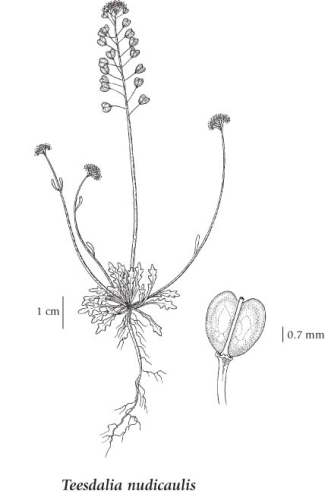Teesdalia nudicaulis (L.) W.T. Aiton
shepherd's cress (barestem teesdalia)
Brassicaceae (Mustard family)
Introduction to Vascular Plants
shepherd's cress (barestem teesdalia)
Brassicaceae (Mustard family)
Introduction to Vascular Plants
Species Information
General:
Annual herb from a slender taproot; stem erect, solitary, simple or freely branched from base, 5-25 cm tall, glabrous.
Leaves:
Basal leaves in a rosette, 1.5-5 cm long, slender-stalked, blades oval to egg-shaped or oblanceolate, entire to pinnately-cut with a few short, obtuse, lateral lobes and larger, broader, often 3-lobed terminal segment; stem leaves, if present, less lobed or entire.
Flowers:
Inflorescence of slender, divergent, 4-8 mm long stalks; petals about 1 mm long; sepals often purplish-tinged, about 0.5 mm long.
Fruits:
Silicles, 3-3.5 mm long, slightly narrower, glabrous; beaks very short.
Illustration

If more than one illustration is available for a species (e.g., separate illustrations were provided for two subspecies) then links to the separate images will be provided below. Note that individual subspecies or varietal illustrations are not always available.
Illustration Source: The Illustrated Flora of British Columbia
Ecology
Ecological Framework for Teesdalia nudicaulis
The table below shows the species-specific information calculated from
original data (BEC database) provided by the BC Ministry of Forests and Range.
(Updated August, 2013)
The table below shows the species-specific information calculated from
original data (BEC database) provided by the BC Ministry of Forests and Range.
(Updated August, 2013)
| Site Information |
Value / Class |
||
|
Avg |
Min |
Max |
|
| Elevation
(metres) |
209 | 122 | 259 |
| Slope
Gradient (%) |
28 | 15 | 50 |
|
Aspect (degrees) |
183 | 140 | 240 |
| Soil
Moisture Regime (SMR) [0 - very xeric; 4 - mesic; 8 - hydric] |
1 | 0 | 2 |
| Modal
Nutrient Regime
Class |
|||
| #
of field plots species was recorded in: |
5 | ||
| Modal
BEC Zone Class |
|||
|
All BEC Zones (# of stations/zone) species was recorded in |
|||
|
Source:
Klinkenberg 2013
|
|||
Habitat and Range
Mesic to dry disturbed areas and waste places in the lowland zone; locally frequent in SW BC; introduced from Europe.Status Information
Synonyms
Synonyms and Alternate Names:
Iberis nudicaulis L.